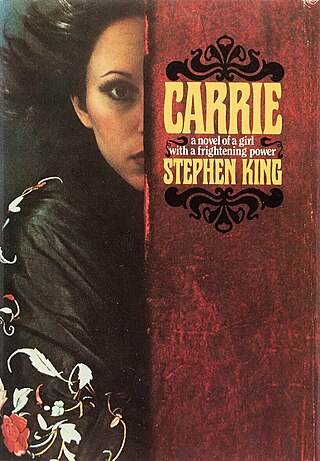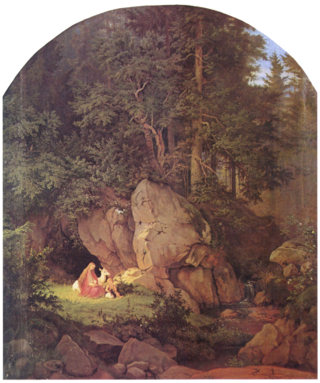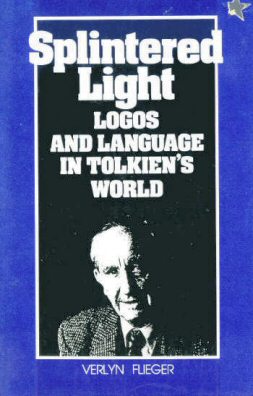Related Research Articles
"On Fairy-Stories" is a 1947 essay by J. R. R. Tolkien which discusses the fairy story as a literary form. It was written as a lecture entitled "Fairy Stories" for the Andrew Lang lecture at the University of St Andrews, Scotland, on 8 March 1939.

Carrie is a 1974 horror novel, the first by American author Stephen King. Set in the town of Chamberlain, Maine, the plot revolves around Carrie White, a friendless, bullied high school girl from an abusive religious household who discovers she has telekinetic powers. Remorseful for picking on Carrie, fellow classmate Sue Snell insists that she go to prom with Sue's boyfriend Tommy Ross, though a revenge prank pulled by one of her bullies on prom night humiliates Carrie, leading her to destroy the entire town with her powers out of revenge. An eponymous epistolary novel, Carrie deals with themes of ostracization and revenge, with the opening shower scene and the destruction of Chamberlain being pivotal scenes.

"Hansel and Gretel" is a German fairy tale collected by the Brothers Grimm and published in 1812 as part of Grimms' Fairy Tales.

A wand is a thin, light-weight rod that is held with one hand, and is traditionally made of wood, but may also be made of other materials, such as metal, bone or stone. Long versions of wands are often styled in forms of staves or sceptres, which could have large ornamentation on the top.

English folklore consists of the myths and legends of England, including the region's mythical creatures, traditional recipes, urban legends, proverbs, superstitions, dance, balladry, and folktales that have been passed down through generations, reflecting the cultural heritage of the country. This body of folklore includes a diverse array of characters, such as heroic figures like Beowulf or Robin Hood, legendary kings like Arthur, and mythical creatures like the Green Man and Black Shuck. These tales and traditions have been shaped by the historical experiences of the English people, influenced by the various cultures that have settled in England over centuries, including Celtic, Roman, Anglo-Saxon, Norse, and Norman elements.

"Rapunzel" is a German fairy tale most notably recorded by the Brothers Grimm and it was published in 1812 as part of Children's and Household Tales. The Brothers Grimm's story was developed from the French literary fairy tale of Persinette by Charlotte-Rose de Caumont de La Force (1698), which itself is an alternative version of the Italian fairy tale Petrosinella by Giambattista Basile (1634).

Charles Godfrey Leland was an American humorist and folklorist, born in Philadelphia, Pennsylvania. He was educated at Princeton University and in Europe.

"Brother and Sister" is a European fairy tale which was, among others, written down by the Brothers Grimm. It is a tale of Aarne–Thompson Type 450. In Russia the story was more commonly known as "Sister Alionushka, Brother Ivanushka", and collected by Alexander Afanasyev in his Narodnye russkie skazki.
The fictional races and peoples that appear in J. R. R. Tolkien's fantasy world of Middle-earth include the seven listed in Appendix F of The Lord of the Rings: Elves, Men, Dwarves, Hobbits, Ents, Orcs and Trolls, as well as spirits such as the Valar and Maiar. Other beings of Middle-earth are of unclear nature such as Tom Bombadil and his wife Goldberry.

The Iron Stove is a fairy tale collected by the Brothers Grimm, as tale number 127. It is Aarne–Thompson type 425A, "The Animal (Monster) as Bridegroom". Dorothea Viehmann prepared the story for the Grimms' collection.

Witch Wood is a 1927 novel by the Scottish author John Buchan that critics have called his masterpiece. The book is set in the Scottish Borders during the Wars of the Three Kingdoms, and combines the author's interests in landscape, 17th century Calvinism, and the fate of Scotland. A significant portion of the dialogue is in Scots.

In folklore and fantasy, an enchanted forest is a forest under, or containing, enchantments. Such forests are described in the oldest folklore from regions where forests are common, and occur throughout the centuries to modern works of fantasy. They represent places unknown to the characters, and situations of liminality and transformation. The forest can feature as a place of threatening danger, or one of refuge, or a chance at adventure.

A hag is a wizened old woman, or a kind of fairy, witch, or goddess having the appearance of such a woman, often found in folklore and children's tales such as "Hansel and Gretel". Hags are often seen as malevolent, but may also be one of the chosen forms of shapeshifting deities, such as The Morrígan or Badb, who are seen as neither wholly benevolent nor malevolent. The word hag can also be synonymous for a witch.
In J. R. R. Tolkien's writings, Elves are the first fictional race to appear in Middle-earth. Unlike Men and Dwarves, Elves do not die of disease or old age. Should they die in battle or of grief, their souls go to the Halls of Mandos in Aman. After a long life in Middle-earth, Elves yearn for the Earthly Paradise of Valinor, and can sail there from the Grey Havens. They feature in The Hobbit and The Lord of the Rings. Their history is described in detail in The Silmarillion.
According to books by Tyson Blue, Stephen J. Spignesi, and Rocky Wood et al., there are numerous unpublished works by Stephen King that have come to light throughout King's career. These allegedly include novels and short stories, most of which remain unfinished. Most are stored among Stephen King's papers in the special collections of the Raymond H. Fogler Library at the University of Maine, some of which are freely accessible to the library's visitors. However, others require King's permission to read. Additionally, there are a number of uncollected short stories, published throughout King's long career in various anthologies and periodicals, that have never been published in a King collection.
Nicneven,Nicnevin or Nicnevan is a witch or fairy queen from Scottish folklore. She is often said to be the same figure as the Gyre-Carling or Hecate, but some scholars disagree with this. It is debated whether the name originally referred to a real woman or a mythical goddess.
"The Old Dude's Ticker" is a short story by American writer Stephen King. Written in the 1970s, it was not published until 2000. It is an homage to Edgar Allan Poe's "The Tell-Tale Heart", adapted to take place in the Vietnam War era and incorporating the slang of the time.

Splintered Light: Logos and Language in Tolkien's World is a 1983 book of literary criticism by the leading Tolkien scholar Verlyn Flieger, in which she argues that light is a central theme of Tolkien's Middle-earth mythology, in particular in The Silmarillion. It has been admired by other scholars to the extent that it has become a core element of Tolkien scholarship.
J. R. R. Tolkien derived the characters, stories, places, and languages of Middle-earth from many sources. Shakespeare's influence on Tolkien was substantial, despite Tolkien's professed dislike of the playwright. Tolkien disapproved in particular of Shakespeare's devaluation of elves, and was deeply disappointed by the prosaic explanation of how Birnam Wood came to Dunsinane Hill in Macbeth. Tolkien was influenced especially by Macbeth and A Midsummer Night's Dream, and he used King Lear for "issues of kingship, madness, and succession". He arguably drew on several other plays, including The Merchant of Venice, Henry IV, Part 1, and Love's Labour's Lost, as well as Shakespeare's poetry, for numerous effects in his Middle-earth writings. The Tolkien scholar Tom Shippey suggests that Tolkien may even have felt a kind of fellow-feeling with Shakespeare, as both men were rooted in the county of Warwickshire.

People, Places and Things is a short story collection by Chris Chesley and Stephen King, self-published in 1960.
References
- 1 2 3 Wood, Rocky; King, Stephen (2012). Stephen King: Uncollected, Unpublished. Overlook Connection Press. pp. 184–185. ISBN 978-1-892950-59-8.
- ↑ Wilson, Suzan (2000). Stephen King: King of Thrillers and Horror. Enslow Publishers. p. 20. ISBN 978-0-766012-33-2.
- ↑ Rolls, Albert (2008). Stephen King: A Biography. ABC-CLIO. pp. 3–4. ISBN 978-0-313345-73-9.
- ↑ Hoover, David L. (2017). Modes of Composition and the Durability of Style in Literature. Taylor & Francis. p. 144. ISBN 978-1-000262-56-8.
- 1 2 Vincent, Bev (2022). Stephen King: A Complete Exploration of His Work, Life, and Influences. becker&mayer! books. p. 12. ISBN 978-0-7-60376-82-9.
- 1 2 Wood, Rocky (2017). Stephen King: A Literary Companion. McFarland & Company. pp. 103–104. ISBN 9780786485468.
- ↑ King, Stephen (1993). "Jhonathan and the Witchs". In Mandelbaum, Paul (ed.). First Words: Earliest Writings from Favorite Contemporary Authors. Algonquin Books. ISBN 978-0-945575-71-9.
- ↑ Mandelbaum, Paul (ed.). First Words: Earliest Writings from Favorite Contemporary Authors. Algonquin Books. ISBN 978-0-9455-7571-9. Archived from the original on March 7, 2013. Retrieved July 7, 2023.
- ↑ Beahm, George (1998). Stephen King from A to Z: An Encyclopedia of His Life and Work. Andrews McMeel Publishing. p. 234. ISBN 978-0-8362-6914-7.